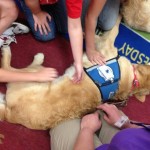Megan Parker carries poop in her purse. At least she does when she’s working with her dog Pepin, who’s trained to track the scat of endangered wildlife.
Having the right scent on hand allows Parker to direct her dog during a search.
Parker and Pepin have helped conservation workers protect wildlife all over the world. With Pepin’s superior sense of smell, the 7-year-old Belgian Malinois has tracked everything from endangered kit foxes in the San Joaquin Valley to the perilously small population of Cross River gorillas in the mountains of Cameroon.
“Scat is a gold mine of information,” said Parker, one of four co-founders of Working Dogs for Conservation, a nonprofit group of six biologists who trained
Scientists can extract DNA — the genetic blueprints found in cells — from scat samples to check the sex of animals and learn who’s related to whom. Stool can also be used to evaluate diets, test hormone levels and check for diseases. By mapping areas where samples are found, an animal’s home range can also be determined. All that information helps conservationists keep tabs on endangered animals without having to hunt, trap or tag them.”People see and hear the world,” said Parker. “But dogs are really good at this because they smell the world.”
With samples of wolverine and cheetah scat from her stash, Parker recently demonstrated Pepin’s search skills. From the moment Parker fastened a bright orange service-dog vest on Pepin, the dog focused on finding his target scents. He sniffed relentlessly around a cavernous lecture hall and trotted briskly among 50 people seated in rows of chairs. In less than 10 minutes Pepin made his finds, alerting Parker by promptly sitting down and throwing her a hard stare.
Pepin is one of nine dogs on staff at Working Dogs for Conservation. A mix of breeds — retrievers, border collies and German shepherds — most of the dogs come from shelters where their high-maintenance traits made them great for detection training, but not so perfect for the easy life of a pet.
The dogs all live with their handlers. That close relationship is part of what makes their teamwork so successful, said Parker. In the field, the dogs work off-leash. So it’s critical to know the dog well enough to know whether he has truly found a target or is just testing the handler, she said.
With highly sensitive noses, dogs such as Pepin have proven they find samples quickly and more accurately than human-based methods, said Alice Whitelaw, another cofounder of the group. Reliability matters because testing scat samples from the wrong animals wastes time and money. Using dogs is also less costly than capturing and radio-collaring animals, which are intensive efforts in terms of manpower, money and handling the wild animals, she said. So far, the dogs have worked on 38 projects in 11 countries.
Scat isn’t the only thing these dogs can find. With scent-discrimination capabilities at least twice as good as those of people, the dogs have nosed out specific plant species — a critical skill on islands where one invasive species can wreak havoc on the rest of the ecosystem, said Whitelaw.
Pepin recently learned to sniff out snares. Poachers use small coils of wire to illegally trap lions and other animals for meat; an elephant can suffocate if a snare entraps their trunk. In two months, Parker and Pepin will travel
to Africa to see if they can find these traps faster than the wildlife workers — or the hapless animals.It takes about four weeks to train a dog on a particular scent. Pepin knows fifteen targets, ranging from invasive snails to endangered plant species and gorilla dung — and, now, snares. The handlers borrowed dog training techniques used for narcotics, bombs and body detection, and modified them for wildlife work. They train the dogs at least twice a week to keep up their scent skills, said Parker.
All the dogs work for play. Every time Pepin finds a target, Parker rewards him with an all-out game of tug with the dog’s favorite toy. Although a tug toy sounds like little reward for a lot of work, the psychology of dogs evolved to rely on people for social reward, said Brian Hare, co-author of “The Genius of Dogs.” If you take a dog with a natural instinct to search and add the bonus of being with humans while searching, you’ve got a powerful ally when a sense of smell is the best avenue to discovering what you are looking for.
Pepin and his canine colleagues aren’t the first dogs to work the wildlife conservation beat. In 1997, Sam Wasser, at the University of Washington, collaborated with Barbara Davenport, a former narcotics detection dog trainer, to assist conservation scientists by training scat-detection dogs. Davenport even taught a dog to follow the scent of whale poop from a boat deck. Now, several universities and private groups have trained dogs to aid wildlife research efforts.
This month, the U.S. Fish and Wildlife Service announced four new four-legged hires — Viper, Butter, Lancer and Locket — to nose out illegal wild animals and contraband, such as elephant tusks and rhino horns, coming across the borders.
“We need all the resources we can possibly muster to help wildlife,” said Georgeanne Wedergren, a zoo docent who watched Pepin work during a noontime presentation. “I’m so glad they save shelter dogs, too.”









 People living with dogs harbor betaproteobacteria and actinobacteria, microbes that normally inhabit the tongue and feet of dogs, as part of their microbiome, according to a recent study. Whether the bacteria pose health concerns was not addressed in the research, but previous work has found that exposure to bacteria can help humans prevent infection and even allergies by priming the immune system.
People living with dogs harbor betaproteobacteria and actinobacteria, microbes that normally inhabit the tongue and feet of dogs, as part of their microbiome, according to a recent study. Whether the bacteria pose health concerns was not addressed in the research, but previous work has found that exposure to bacteria can help humans prevent infection and even allergies by priming the immune system. 

